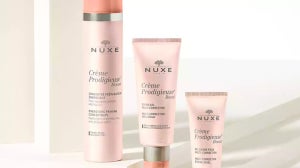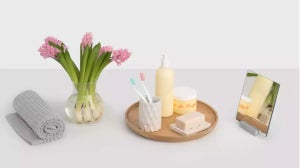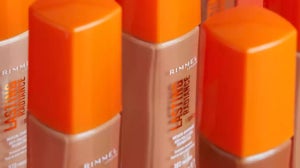
What are the skin types?
There are five main skin types, and most people fit into one of these categories.
Oily
Dry
Combination
Sensitive
Normal
Let’s learn a little more about these skin types, so you can start to figure out where you fall.
Oily
An oily skin type is just that – skin which is naturally oily all over. If you have oily skin, you might also notice your pores appear large and often get clogged. Sadly for those with this skin type skin, blackheads, whiteheads, and other acne types are also common.
How to tell if your skin type is oily
There are a few things to look out for if you think your skin type is oily. Does your face look shiny, or get shiny throughout the day? Does makeup seem to slide off? Do you have blackheads or pimples, or enlarged pores on your nose, chin, or forehead? If your answer is yes, you might have oily skin.
Dry
On the opposite end of the spectrum, we have dry skin. This skin type lacks the natural oils that contribute to moisture and softness. Dry skin often drinks up moisturising products and can be flaky, tight, and rough. If you have dry skin, you might benefit from almost invisible pores and less frequent breakouts.
How to tell if your skin type is dry
Think you might have dry skin? Ask yourself a few questions to find out. Do you have almost invisible pores? Does your complexion look dull and rough? Do you have visible lines or skin which creases easily? Does your face seem to drink up moisturiser all year round? If the answer is yes, you might have dry skin.
Combination
Now things get a little more complicated. Combination skin is literally a combination of oily, dry, and normal skin, where areas of your face fall into different categories.
How to tell if your skin type is a combination
Combination skin might seem tricky to identify, but it’s pretty straightforward if you consider your nose, forehead, and cheeks separately. If, for example, you have enlarged pores on your nose, but flaky patches on your forehead, you might have a combination of oily and dry skin.
Sensitive
Sensitive skin can be pretty high maintenance, but it’s nothing you can’t handle once you understand your needs. This skin type is easily irritated and might react badly to new products or harsh environments. If you have sensitive skin, it’s best to keep your routine to a minimum and avoid any fragranced, abrasive, products.
How to tell if your skin type is sensitive
Sensitive skin is easily irritated by lots of factors. You can tell if you have it by assessing your face after exposure to cold, sunlight, new products, or products with potent ingredients. If you’re no stranger to a rash or itchy reaction, or skincare sometimes stings, you probably have sensitive skin.
Normal
Normal isn’t an adjective we like to throw around lightly, since the word has different meanings to all of us. Still, it is one of the five identifiable skin types, so we need to mention it here. Normal skin is – let’s face it – the dream. This skin type boasts perfectly balanced oils, delicate pores, good blood circulation, and a smooth texture. It’s also unlikely to react to external factors and doesn’t see blemishes often.
How to tell if your skin type is normal
You might fall into this category if you have soft, smooth skin, and don’t get spots or blackheads very often. Lucky you!
Choosing the right skincare for your skin type
Now you know your skin type, it’s time to tailor your routine to suit. Here we’ll give you some basic pointers for each skin type. From there, choose the products which appeal to you most and get ready to treat your skin right.
Oily skincare routine
Oily skin often has large pores and a shiny appearance. Your goal will be to reduce oil production by making sure you’re always hydrated. Stay in control with a gentle cleanser in the morning. Follow up with an alcohol-free toner, an AHA or BHA serum, and an oil-free moisturiser. When it comes to sunscreen, look for a zinc oxide option, which will leave you with more of a matte finish.
At night, use your gentle cleanser, toner, and an oil-free moisturiser. Don’t fall into the trap of thinking your oily skin doesn’t need moisturiser. The key is to keep it hydrated, so your sebum production doesn’t kick into overdrive and make your skin greasier. Oily skin can also benefit from a clay mask treatment once a week.
Dry skincare routine
If you have dry skin, your main goal is to keep things hydrated. Using a cleansing lotion which doesn’t foam up is a great place to start. Wash your face both morning and night, and follow with toner on both occasions. After your morning clean, apply a hydrating moisturiser with SPF.
At night, a retinol serum, eye cream, and hydrating moisturiser can help replenish your dry skin. Look out for ingredients like rosehip seed oil, almond oil, and evening primrose oil.
Combination skincare routine
For combination skin, choose skincare that addresses a range of issues. You don’t need to use two routines to treat your dry and oily areas. Instead, find one that looks after both concerns. A gentle cleansing lotion will be comfortable on your dry skin and work well on oily patches too. Follow up with a simple balancing toner and a lightweight moisturiser both morning and night.
Like if you had oily skin, use a zinc oxide SPF in the morning. And just like for dry skin, use retinol serum at night.
Sensitive skincare routine
Sensitive skin gets red and irritated quickly, so you’ll need to be careful you don’t do anything to cause a flareup. Use a gentle, sulfate-free cleansing lotion both morning and night, followed by an alcohol-free toner. Finish your three-step routine with a fragrance-free moisturiser, and our favourite non-irritating zinc oxide SPF in the morning.
Normal skincare routine
If you have balanced skin, your skincare routine can involve a simple cleanser, toner, and moisturiser. Choose a moisturiser with SPF for your morning application, and a creamier product to nourish you at night.
Can your skin type change?
Yes! Your skin type can change over time, so you should reassess every once in a while to make sure you’re still following the best routine. This won’t happen without a cause; hormonal, environmental, age, and health factors can all play a part in the change. Keep an eye on your complexion and make sure you’re always treating your skin with the products it needs, not just the ones that are having a moment in the spotlight.









